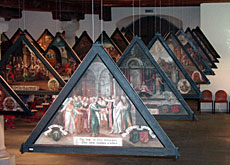Lucerne art treasures make belated reappearance

It was a sad day for Lucerne when the final section of its Hofbrücke - a centuries-old wooden bridge - was dismantled on 1852.
At the same time a unique series of religious paintings attached to its roof disappeared from public view.
But now, 150 years later, the city authorities have swung into action and the paintings, restored to their former glory, can be seen again.
But why has it taken so long?
“After 1852 the pictures were taken to various places in the city for storage,” says Heinz Horat, director of Lucerne’s history museum, where the pictures are being exhibited for the first time in 150 years.
Astonishingly, not only did 226 of the original 239 triangular paintings survive their long exile in old towers and storerooms, but considering their 16th century origins they now show little sign of ageing.
This is thanks to restoration work carried out over the past five years by experts in eight specialist studios.
Restoration work
Their use of infrared reflectography helped them respect the special painting techniques of the different artists involved.
“Strangely, we know little about the artists,” Horat told swissinfo.
“Johannes of Leiden was the only one to leave his signature, but it’s clear that all the artists were influenced by the Dutch style of that particular time.”
The city elders decided in about 1552 to decorate the 400-metre long bridge with paintings depicting scenes from the Bible, starting with Adam and Eve and ending with the Last Judgment.
Their decision was a reaction to the Protestants’ destruction of religious paintings during the first half of the 16th century.
“The rise of Protestantism had left Catholic regions such as Lucerne in an isolated position,” says Horat.
“Influenced by its good relations with northern Italy, Lucerne then came up with the idea of following the Old and New Testament through a path, in other words on the bridge.”
Vital link
In fact the Hofbrücke was as much a path as a bridge.
Originally built around 1260, it linked the town with the Hofkirche parish church at a time when Lake Lucerne was surrounded by marshland and settlements were often flooded.
But it was specifically designed as a footbridge unsuitable for vehicles, and by the 19th century the construction of such luxury hotels as the Schweizerhof had rendered it obsolete.
Thus it was replaced by the Schweizerhofquai, a road in more or less the same position on what was known as “the bay of Lucerne”.
This exhibition, which lasts until January 12, sheds light on the history of a bridge whose former existence is little-known outside Lucerne.
“A Path of Pictures” – the exhibition title – will mean much more than a stroll along memory lane for many of the local people who will visit it.
Horat says the city authorities and his museum are hoping that the reappearance of the paintings will lead to a public debate on a future permanent home for them.
“It could be difficult to find somewhere big enough,” he concedes. “After all, we are seeking an exhibition space 400 metres long to do justice to these pictures.”
swissinfo, Richard Dawson
The Hofbrücke was constructed in 1260.
In the mid-16th century the wooden covered bridge was decorated with paintings of biblical scenes.
Demolition of the old bridge was completed in 1852 and it was replaced by a road suitable for vehicles.
The paintings were dispersed around Lucerne until 1997.

In compliance with the JTI standards
More: SWI swissinfo.ch certified by the Journalism Trust Initiative
You can find an overview of ongoing debates with our journalists here. Please join us!
If you want to start a conversation about a topic raised in this article or want to report factual errors, email us at english@swissinfo.ch.